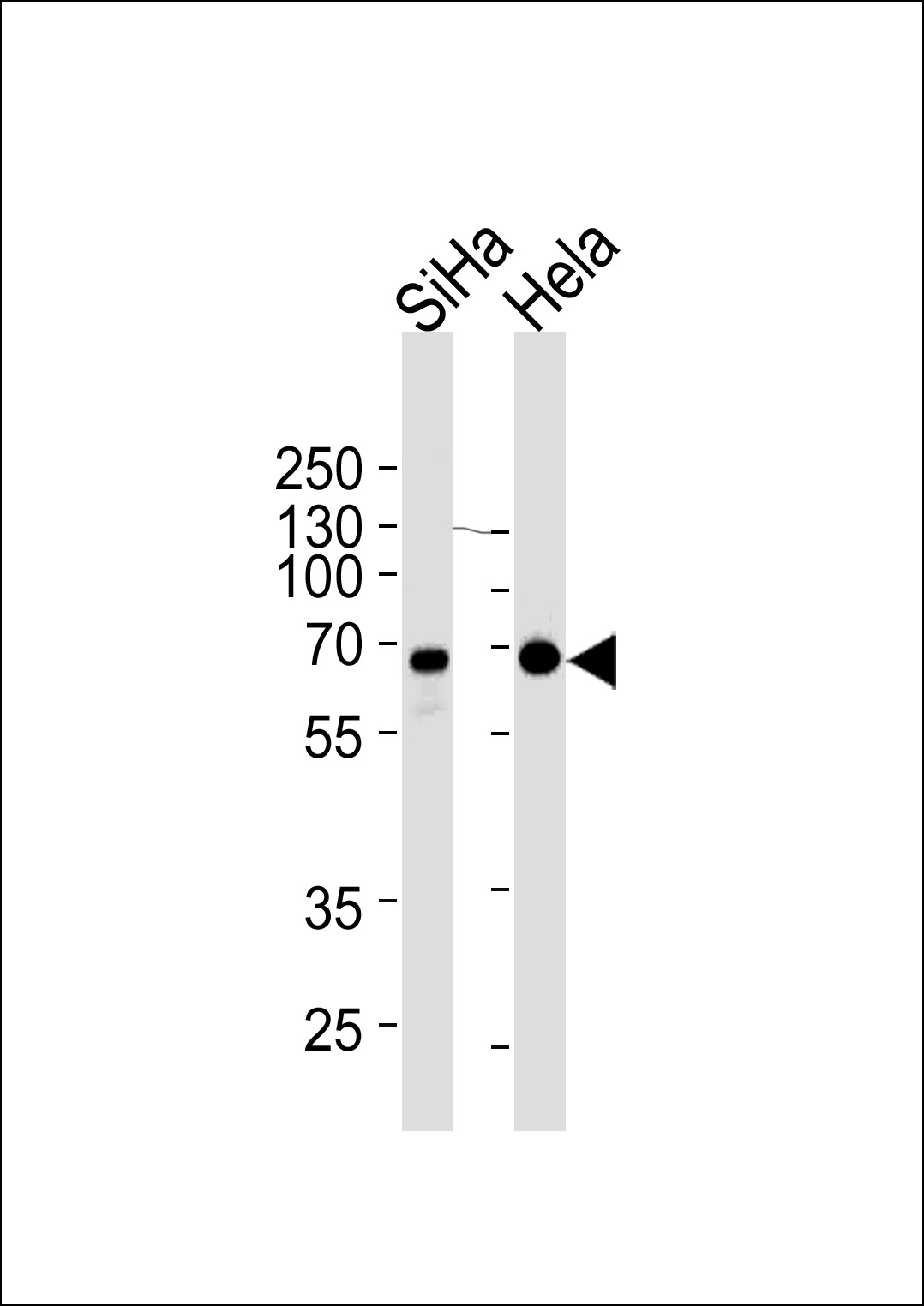NLK Antibody
Mouse Monoclonal Antibody (Mab)
- 产品详情
- 实验流程
- 背景知识
Application
| WB, E |
|---|---|
| Primary Accession | Q9UBE8 |
| Reactivity | Human, Rat, Mouse |
| Host | Mouse |
| Clonality | Monoclonal |
| Isotype | IgG2a |
| Clone Names | 1146CT24.2.1 |
| Calculated MW | 58283 Da |
| Gene ID | 51701 |
|---|---|
| Other Names | Serine/threonine-protein kinase NLK, Nemo-like kinase, Protein LAK1, NLK, LAK1 {ECO:0000312|EMBL:AAD560131} |
| Target/Specificity | Purified His-tagged NLK protein was used to produced this monoclonal antibody. |
| Dilution | WB~~1:1000 E~~Use at an assay dependent concentration. |
| Format | Purified monoclonal antibody supplied in PBS with 0.09% (W/V) sodium azide. This antibody is purified through a protein G column, followed by dialysis against PBS. |
| Storage | Maintain refrigerated at 2-8°C for up to 2 weeks. For long term storage store at -20°C in small aliquots to prevent freeze-thaw cycles. |
| Precautions | NLK Antibody is for research use only and not for use in diagnostic or therapeutic procedures. |
| Name | NLK |
|---|---|
| Synonyms | LAK1 {ECO:0000312|EMBL:AAD56013.1} |
| Function | Serine/threonine-protein kinase that regulates a number of transcription factors with key roles in cell fate determination (PubMed:12482967, PubMed:14960582, PubMed:15004007, PubMed:15764709, PubMed:20061393, PubMed:20874444, PubMed:21454679). Positive effector of the non-canonical Wnt signaling pathway, acting downstream of WNT5A, MAP3K7/TAK1 and HIPK2 (PubMed:15004007, PubMed:15764709). Negative regulator of the canonical Wnt/beta-catenin signaling pathway (PubMed:12482967). Binds to and phosphorylates TCF7L2/TCF4 and LEF1, promoting the dissociation of the TCF7L2/LEF1/beta-catenin complex from DNA, as well as the ubiquitination and subsequent proteolysis of LEF1 (PubMed:21454679). Together these effects inhibit the transcriptional activation of canonical Wnt/beta-catenin target genes (PubMed:12482967, PubMed:21454679). Negative regulator of the Notch signaling pathway (PubMed:20118921). Binds to and phosphorylates NOTCH1, thereby preventing the formation of a transcriptionally active ternary complex of NOTCH1, RBPJ/RBPSUH and MAML1 (PubMed:20118921). Negative regulator of the MYB family of transcription factors (PubMed:15082531). Phosphorylation of MYB leads to its subsequent proteolysis while phosphorylation of MYBL1 and MYBL2 inhibits their interaction with the coactivator CREBBP (PubMed:15082531). Other transcription factors may also be inhibited by direct phosphorylation of CREBBP itself (PubMed:15082531). Acts downstream of IL6 and MAP3K7/TAK1 to phosphorylate STAT3, which is in turn required for activation of NLK by MAP3K7/TAK1 (PubMed:15004007, PubMed:15764709). Upon IL1B stimulus, cooperates with ATF5 to activate the transactivation activity of C/EBP subfamily members (PubMed:25512613). Phosphorylates ATF5 but also stabilizes ATF5 protein levels in a kinase-independent manner (PubMed:25512613). Acts as an inhibitor of the mTORC1 complex in response to osmotic stress by mediating phosphorylation of RPTOR, thereby preventing recruitment of the mTORC1 complex to lysosomes (PubMed:26588989). |
| Cellular Location | Nucleus {ECO:0000250|UniProtKB:O54949}. Cytoplasm {ECO:0000250|UniProtKB:O54949}. Note=Predominantly nuclear. A smaller fraction is cytoplasmic. {ECO:0000250|UniProtKB:O54949} |
For Research Use Only. Not For Use In Diagnostic Procedures.
Provided below are standard protocols that you may find useful for product applications.
BACKGROUND
Serine/threonine-protein kinase that regulates a number of transcription factors with key roles in cell fate determination. Positive effector of the non-canonical Wnt signaling pathway, acting downstream of WNT5A, MAP3K7/TAK1 and HIPK2. Activation of this pathway causes binding to and phosphorylation of the histone methyltransferase SETDB1. The NLK-SETDB1 complex subsequently interacts with PPARG, leading to methylation of PPARG target promoters at histone H3K9 and transcriptional silencing. The resulting loss of PPARG target gene transcription inhibits adipogenesis and promotes osteoblastogenesis in mesenchymal stem cells (MSCs). Negative regulator of the canonical Wnt/beta-catenin signaling pathway. Binds to and phosphorylates TCF7L2/TCF4 and LEF1, promoting the dissociation of the TCF7L2/LEF1/beta-catenin complex from DNA, as well as the ubiquitination and subsequent proteolysis of LEF1. Together these effects inhibit the transcriptional activation of canonical Wnt/beta-catenin target genes. Negative regulator of the Notch signaling pathway. Binds to and phosphorylates NOTCH1, thereby preventing the formation of a transcriptionally active ternary complex of NOTCH1, RBPJ/RBPSUH and MAML1. Negative regulator of the MYB family of transcription factors. Phosphorylation of MYB leads to its subsequent proteolysis while phosphorylation of MYBL1 and MYBL2 inhibits their interaction with the coactivator CREBBP. Other transcription factors may also be inhibited by direct phosphorylation of CREBBP itself. Acts downstream of IL6 and MAP3K7/TAK1 to phosphorylate STAT3, which is in turn required for activation of NLK by MAP3K7/TAK1.
REFERENCES
Kehrer-Sawatzki H., et al. Gene 251:63-71(2000).
Wang C., et al. Submitted (AUG-1999) to the EMBL/GenBank/DDBJ databases.
Ota T., et al. Nat. Genet. 36:40-45(2004).
Ishitani T., et al. Mol. Cell. Biol. 23:131-139(2003).
Ohkawara B., et al. Genes Dev. 18:381-386(2004).
终于等到您。ABCEPTA(百远生物)抗体产品。
点击下方“我要评价 ”按钮提交您的反馈信息,您的反馈和评价是我们最宝贵的财富之一,
我们将在1-3个工作日内处理您的反馈信息。
如有疑问,联系:0512-88856768 tech-china@abcepta.com.























 癌症的基本特征包括细胞增殖、血管生成、迁移、凋亡逃避机制和细胞永生等。找到癌症发生过程中这些通路的关键标记物和对应的抗体用于检测至关重要。
癌症的基本特征包括细胞增殖、血管生成、迁移、凋亡逃避机制和细胞永生等。找到癌症发生过程中这些通路的关键标记物和对应的抗体用于检测至关重要。 为您推荐一个泛素化位点预测神器——泛素化分析工具,可以为您的蛋白的泛素化位点作出预测和评分。
为您推荐一个泛素化位点预测神器——泛素化分析工具,可以为您的蛋白的泛素化位点作出预测和评分。 细胞自噬受体图形绘图工具为你的蛋白的细胞受体结合位点作出预测和评分,识别结合到自噬通路中的蛋白是非常重要的,便于让我们理解自噬在正常生理、病理过程中的作用,如发育、细胞分化、神经退化性疾病、压力条件下、感染和癌症。
细胞自噬受体图形绘图工具为你的蛋白的细胞受体结合位点作出预测和评分,识别结合到自噬通路中的蛋白是非常重要的,便于让我们理解自噬在正常生理、病理过程中的作用,如发育、细胞分化、神经退化性疾病、压力条件下、感染和癌症。






